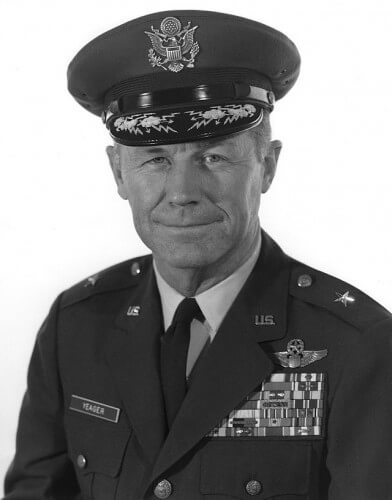During the flight, Jaeger's plane was launched from the carrier plane, began flying at a speed of Mach 0.83 and gradually increased to Mach 1.06, at an altitude of 43,000 feet. During the flight, the first supersonic boom was also heard, which many of the spectators on the ground did not expect.

Written by: Udi Lam
On 14/10/1947, the historic flight of General Charles Ellwood "Chuck" Yeager, in which he broke the sound barrier for the first time, was held in a Bell XS-1 airplane.
Jaeger began his service in the American Air Force in 1941 as a mechanic, but in 1942 he was accepted for a pilot's course; He served during the years 1943 - 1945 as a P-51 Mustang pilot, shot down 13 German planes (of which 5 on one day and another 4 on another day) and was even shot down once, parachuted and with the help of the French underground managed to escape and return to Britain. Unusually, he was allowed by General Eisenhower, the commander of the Allied forces, to fly operational flights again.
After the war, Jaeger began to serve as a test pilot for various Air Force planes that underwent repairs and maintenance treatments, and thus experienced flying almost all of the Air Force's fighter planes, including the P-80 Shooting Star, the first American jet fighter. The commander of the flight test unit, Colonel Albert Boyd, who is considered the founder of the modern field of flight tests, chose him to be the first to try to fly beyond the speed of sound - a limit that many pilots and experts estimated at the time was impassable, and that an attempt to cross it would result in severe shocks that would break the fuselage into pieces.
The flights began with the XS-1 plane, which had a rocket engine and was carried by a B-29 bomber. Jaeger made several flights, in each of which he got a little closer to the Mach 1 limit; In his eighth flight he discovered that when he approaches the speed of sound, the elevator becomes ineffective (this phenomenon led years later to changing the mechanics of the elevator in fighter planes, so that the entire aileron changes angle and not just its rear lip). After a way was found to overcome this problem as well (by slight changes of the angle of incidence, which were probably feasible in this plane) Jaeger went on the flight of October 14, during which a launcher from the carrier plane began to fly at a speed of Mach 0.83 and gradually increased to – Mach 1.06, at 43,000 feet. During the flight, the first supersonic boom was also heard, which many of the spectators on the ground did not expect.
A video describing Chuck Yeager's flight
About the X-planes (experimental planes) of different generations:
From the website dedicated to Jaeger's life history:

One response
There was a full-length film about the story, but in order to intensify the dramatization, they showed in the film as if the action of the rudder reverses when passing the speed of sound. (Hollywood does not get excited about inaccuracies in the truth). In his book Chuck Yeager writes about the matter.
Another interesting thing - the plane did not have an ejection seat, and it is a plane with a rocket engine (liquid) and supersonic speed! It's a huge risk. In the event of a malfunction, he had no chance to get out. Only the X4 was fitted with an ejector seat. Yeager is now 91 years old and lives in California.